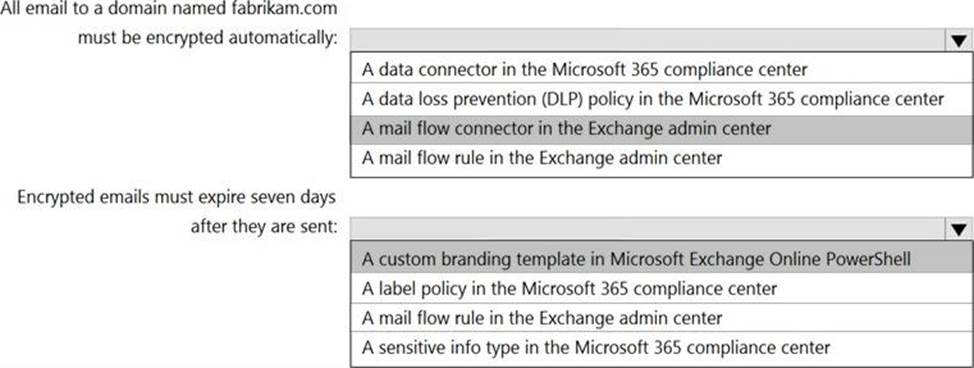Microsoft SC-400 Real Exam Questions
The questions for SC-400 were last updated at Dec 16,2025.
- Exam Code: SC-400
- Exam Name: Microsoft Information Protection Administrator
- Certification Provider: Microsoft
- Latest update: Dec 16,2025
You need to recommend a solution to configuration the Microsoft 365 Records management settings by using the CSV file must meet the compliance requirements.
What should you recommend?
- A . From the Microsoft 365 compliance center, import the CSV file to a file plan.
- B . Use EdmUploadAgent.exe to upload a hash of the CSV to a datastore.
- C . Use a PowerShell command that pipes the import csv cmdlet to the New-RetentionPolicy cmdlet.
- D . Use a PowerShell command that pipes the import-csv cmdlet to the New-Label cmdlet.
You have a Microsoft SharePoint Online site that contains employee contracts in a document library named Contracts.
The contracts must be treated as records in accordance with your company’s records management policy.
You need to implement a solution to automatically mark all the contracts as records when they are uploaded to Contracts.
Which two actions should you perform? Each correct answer presents part of the solution. NOTE: Each correct selection is worth one point. (Choose two.)
- A . Create a sensitivity label.
- B . Create a retention label.
- C . Configure a default label on the Contracts document library.
- D . Create a retention policy.
- E . Create a SharePoint Records Center.
- F . Create a retention lock.
Your company manufactures parts that are each assigned a unique 12-character alphanumeric serial number. Emails between the company and its customers refer in the serial number.
You need to ensure that ail Microsoft Exchange Online emails containing the serial numbers are retained for five years.
Which three objects should you create? Each correct answer presents part of the solution. NOTE: Each correct selection is worth one point.
- A . a trainable classifier
- B . a sensitive info type
- C . a retention polity
- D . a data loss prevention (DLP) policy
- E . an auto-labeling policy
- F . a retention label
- G . a sensitivity label
HOTSPOT
You are implementing Microsoft Office 365 Message Encryption (OME) for a Microsoft 365 tenant named contoso.com.
You need to meet the following requirements:
• All email to a domain named fabhkam.com must be encrypted automatically.
• Encrypted emails must expire seven days after they are sent-
What should you configure for each requirement? To answer, select the appropriate options NOTE: Each correct selection is worth one point.

You are configuring a retention label named Label1 as shown in the following exhibit.

You need to ensure that documents that have Label1 applied are deleted three years after the end of your company’s fiscal year.
What should you do?
- A . Create a new event type.
- B . Select Only delete items when they reach a certain age.
- C . Modify the Retention period setting.
- D . Set At the ends of the retention period to Trigger a disposition review.
HOTSPOT
While creating a retention label, you discover that the following options are missing:
✑ Mark items as a record
✑ Mark items as a regulatory record
You need to ensure that the options are available when you create retention labels in the Microsoft 365 compliance center.
How should you complete the PowerShell script? To answer, select the appropriate options in the answer area. NOTE: Each correct selection is worth one point.

You are planning a data loss prevention (DLP) solution that will apply to computers that run Windows 10.
You need to ensure that when users attempt to copy a file that contains sensitive information to a USB storage device, the following requirements are met:
* If the users are members of a group named Group1, the users must be allowed to copy the file, and an event must be recorded in the audit log.
* All other users must be blocked from copying the file.
What should you create?
- A . one DLP policy that contains one DLP rule
- B . two DLP policies that each contains one DLP rule
- C . one DLP policy that contains two DLP rules


